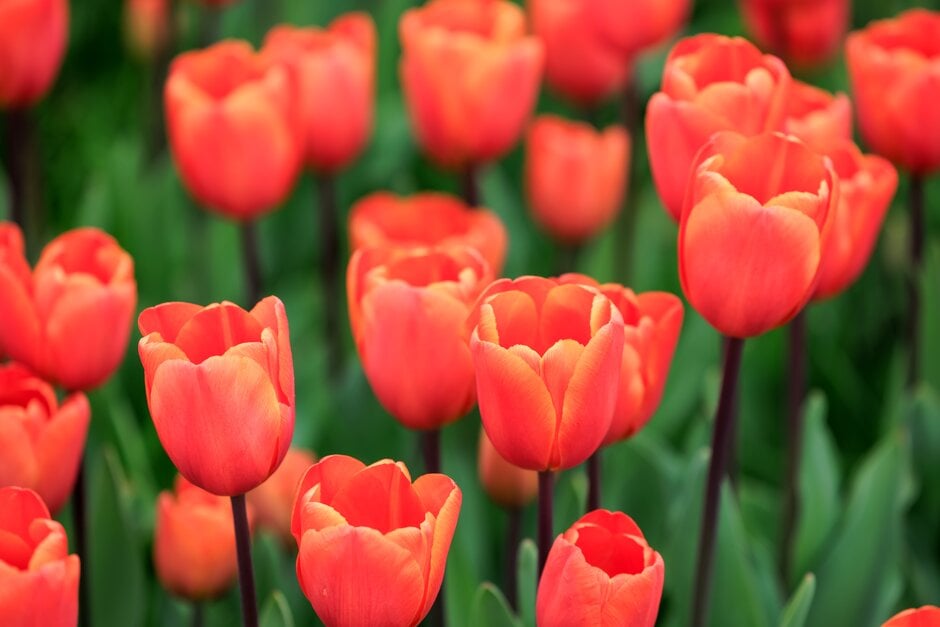Tulipa (tulip), double late, parrot and coronet trial 2025
Objectives and purpose of the trial
Plants and location
What was planted?
A total of 80 cultivars of double late, parrot and coronet tulips were planted out as part of the trial. More specifically, there were 43 cultivars of double late tulips, 30 cultivars of parrot tulips, and seven cultivars of coronet tulips. The bulbs came from leading tulip suppliers in the UK who source them from growers and exporters in the Netherlands. These tulip classifications have the following characteristics:
- Double late tulips have many petals and bloom in late spring. Some resemble peonies and are known as peony tulips
- Parrot tulips have laciniate petals, this means the petals are divided into deep, narrow, irregular segments and resemble feathers. Some are striped with contrasting colours. Tulips like these were first described in the early 17th century
- Coronet tulips are a relatively new introduction. Their petals curl inwards from the sides towards the middle, creating a crown-shaped flower. They have a long flowering period
Where is it planted?
The tulip bulbs were planted in the open ground across two trial beds in the Trials Garden at RHS Wisley, setting the stage for a striking seasonal trial display. Here are some considerations for planting out tulips:
- The best time to plant tulips is in November
- Pick a sunny, free-draining site in the garden
- Alternatively, plant them in containers in peat-free compost that drains well
- Remember to water them during the growing season
- Double late, parrot and coronet tulips all flower in late spring, which is why they are best planted together
Judges and criteria
Judges of the trial
The 2025 Tulipa judges are: Teresa Clements (Chair, RHS Bulb Expert Group), John Amand (director, Jacques Amand International), Camilla Bassett-Smith (television presenter and writer), Lucy Bellamy (journalist and author), Jenny Bowden (RHS Advisor), Fergus Garrett (Head Gardener, Great Dixter), Clare Smith (owner, Plant Passion), Adam Taylor (director, Taylors Bulbs), Richard Wilford (Royal Botanic Gardens, Kew) and Pollyanna Wilkinson (garden designer).
Judging criteria
The following factors are all taken into consideration as part of the judging of the trial:
- Overall appearance – proportions, sturdiness and foliage
- Flower impact – colour, size and shape
- Length of flowering period
- Weather and pest resistance
- Uniformity of height and colour
Cultivation
Planting process
In November 2024, the Garden Team carefully planted tulip bulbs into individual shallow trenches, 10cm deep x 50cm wide x 100cm long, with a layer of horticultural grit at the base of each trench to improve drainage. The bulbs were organised alphabetically within the respective groups of double late, parrot and coronet tulips.
Each cultivar entry was spaced 60cm apart, with a total of 80 entries planted across two trial beds. After planting, the beds were covered with strulch to suppress weeds. To protect the area from badgers, a short solar-powered electric fence was installed around the exterior of the beds.
Does it matter which way up you plant tulip bulbs?
Gardeners have always been told that tulip bulbs should be planted with the point facing upwards. But does it really matter? Barbara Beyrath from the RHS Trials Curatorial investigates:
How we’re managing plant health

How to grow tulips
Explore all the information you need to know to grow and care for tulips in your garden
Suppliers to the trial
List of plants in the trial
Handy tools and information
- Full article - Filter for AGM plants and refine by colour, height and season of interest
Find an AGM plant online
Filter for AGM plants and refine by colour, height and season of interest - Full article - Explore advice and helpful tips from our resident experts
Gardening advice
Explore advice and helpful tips from our resident experts - Full article - Check how hardy plants are using the RHS hardiness ratings system
Hardiness ratings
Check how hardy plants are using the RHS hardiness ratings system - Full article - A new app packed with gardening know-how at your fingertips
RHS Grow app
A new app packed with gardening know-how at your fingertips
Get in touch
For more information on our RHS Plant Trials or to access older trial reports, please get in touch with our team via email at trials@rhs.org.uk.
Get involved
The Royal Horticultural Society is the UK’s leading gardening charity. We aim to enrich everyone’s life through plants, and make the UK a greener and more beautiful place.

